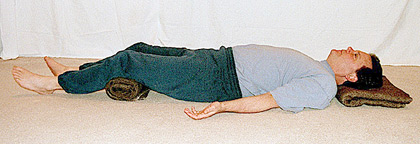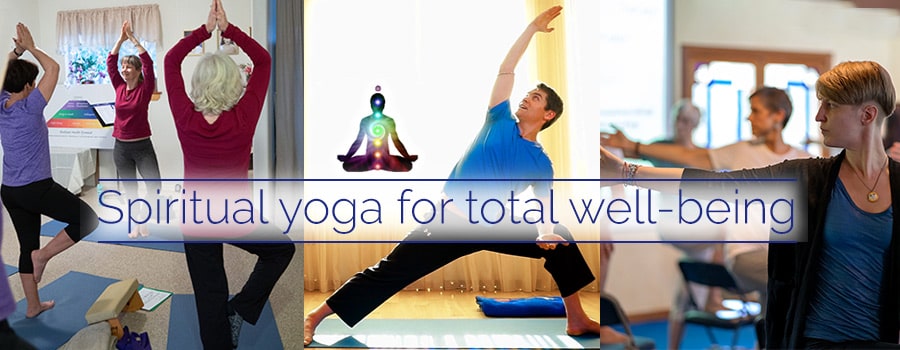Therapeutic Yoga for the Lower Back
Picture this: You are about to begin teaching your Thursday evening yoga class when in walks a new student: a middle-aged man, slightly overweight, wearing glasses and a smile on his face. In making your usual introductions, you learn that his name is Randy. You ask him, “Do you have any injuries, or anything else that I should know about?”
“Well, just my back,” he answers.
“Oh? What part of your back?” you inquire.
“The disc at L3 [third lumbar vertebra] is herniated, and L4 and L5 are fused together from a previous surgery. I have sciatica, and sometimes the pain radiates all the way to my toes.
“I haven’t had any luck with physical therapy (P.T.), and the cortisone shots for the pain aren’t working so well anymore. My doctor wants another M.R.I. [Magnetic Resonance Imaging, a high-tech — and expensive — way to get a look at the inside of the body, especially soft tissues, which X-rays cannot reveal] before discussing surgery again. I keep hearing that yoga can help people with back problems, so here I am!” he concludes.
You try not to leave your mouth open with your jaw hanging and say “Huh?” Instead you compose yourself and say, “Did your doctor say it was okay to do yoga?” “Well, he said he doesn’t know anything about it, and it was up to me if I wanted to try it, so here I am.”
“Are there any movements that you should not do?”
“No. I just can’t stand for very long, and I am never comfortable sitting, and I cannot lie flat on my back.”
Don’t Just Stand There. Do Something!
Okay, now what do you do? Choose one of the following:
A. Tell him to go home.
B. Tell him to go to the hospital emergency room.
C. Try to wake yourself up in case this is just a bad dream.
D. Have him start with Surya Namaskar.
E. None of the above.
Let’s look at these options:
A. If you tell him to go home, after he has made the effort (consider his condition and you will realize how great the effort has been) to try a yoga class, he may never pursue yoga again.
You might want to refer him to another class that might be more appropriate for him, and encourage him to take private classes at least at first. However, in the meantime, here he is.
So unless you feel totally overwhelmed and uncomfortable, it would be really nice to be able to offer him a few conservative asanas and pranayamas that will give him a taste for what yoga is like. That way he can feel how yoga might be helpful for him — and you won’t have to change your entire class plan for his sake. So don’t choose A.
B. His doctor hasn’t sent him to the hospital yet, so that choice might seem a little hysterical on your part. Scratch option B.
C. The reality is that as yoga becomes more mainstream, and as the media continues to publicize its many benefits, the above scenario will likely become more common. So C is not likely to work, either.
D. Hopefully, you learned enough in Yoga Teacher Training to know that if you choose this option, then at the end of class, option B may very well be a wise follow-up choice. In other words: don’t choose D!
E. This is the best option. Unfortunately, there is no simple and universal “this is what you do for students with low back problems” answer.
The range of severity is great, and the causes and diagnoses for low back pain are many — and often complex. They range from a strained muscle due to an overly zealous workout, to ruptured discs, broken bones, and tumors.
The onset of an injury can develop slowly over a period of years, or suddenly as in a car accident. Some back problems are hereditary or a result of poor posture. The list goes on and on. So, where do we begin in order to sort it all out and figure out what to do when students with lower back problems come to our classes?
Let’s start with the easy cases; we’ll come back to Randy later. The good news is that if you are teaching proper body mechanics and alignment as you move your students in and out of level-appropriate asanas, many students with minor low back problems will find that a balanced, level-appropriate class is all that they need to reduce or completely rid themselves of lower back pain.
Additionally, simply using Ananda Yoga’s® affirmations will help relieve more effectively many of the underlying emotional and psychological stresses that may be the root cause, or a continuing aggravation, of the lower back problem.
As a teacher you can further facilitate this process simply by knowing a few asanas and movements to avoid, as well as what to emphasize for your students with lower back concerns.
Ask Questions
A student may come to you declaring a specific diagnosis for their back condition, or he may have some vague, general problem that he is unable to articulate well. I usually ask students in either category nearly the same questions to make my own evaluation of the situation.

As important as it is to emphasize the need for “normal” students to maintain the spine’s natural curves, it’s even more important when you are working with students with back problems.
I do this for several reasons. Sometimes a student assumes a particular diagnosis because he thinks it sounds like what his friend has, when in fact the problem is actually not the same as the friend’s problem.
Or perhaps he was given a diagnosis from a doctor ten years ago, yet now his condition is different. The questions also provide insights into the severity of a condition.
As an example, some students who have “sciatica” may have such a mild case that they can do perhaps most, if not all, of the same asanas that the rest of the class does. Others may have a “sciatica” that is so acute that they can only do a few of the most basic therapeutic asanas. (To distinguish the severity, see the questions below that refer to type of pain and impact on daily activities.)
- Have your student touch where it hurts — it may be more than one place, and it may move from time to time.
- Ask the student what aggravates it, and are any of his daily activities (vacuuming, sleeping, walking, etc.) compromised because of it. This information will help you determine what types of asanas you may need to have the student avoid.
- Ask the student if the pain is dull, achy, sharp, tingling, numb, or radiating. A “yes” answer to any of the last four descriptions may indicate nerve involvement, and you should proceed cautiously to avoid further aggravation.
- Always continue to ask a student questions about how asanas feel during his or her practice as well as afterwards. This helps you to know what is working and what is not working.
Remember that you are not a doctor, so never tell a student what condition he has in any way that might sound like a diagnosis.
In fact, as a yoga teacher you do not necessarily need a specific diagnosis. All you need to know is what works and what does not work for each particular student. If you have an accurate diagnosis from a qualified health care practitioner, it simply relieves you of some — but not all — of your problem-solving work.
So for best results, ask questions and observe — and watch out for the old “it feels fine” response when the student’s face is all screwed up with tension and sweat is dripping from his forehead!
What to Avoid
To keep from doing any harm, the student should avoid:
- Anything that causes pain or discomfort.
- Sitting asanas, which in general put the most stress on the lower back.
- Standing and seated forward bends, unless you are sure that the student can maintain the natural curves in his spine through the support of a wall, chair, straps, and/or pillows without discomfort, and that you can help him do the bend in such a way that he will feel the stretch, not in his lower back, but rather in his legs.
- Backward bends that may put too much weight, pressure, or strain on the lower back. If you are not sure, ask the student if he feels, weight, pressure, strain, tingling, sharpness, or any other sensation that simply does not feel “right”. If he feels any of those sensations, see if you can adjust his position so he doesn’t feel the sensation(s); otherwise, have him avoid that asana.
- Twists, unless you are sure that your student does not have a pinched nerve or bulging disc. You would know that it is a possibility if he has told you that is his diagnosis, or if he experiences, numbness, tingling, or sharp pain.
- When having your student do sideways bends, it is essential that he does not inadvertently twist. Watch his alignment carefully, so that he keeps the stretch on the side and does not put pressure on the lower back.
Cautions
Delayed reaction
Sometimes a movement or position that aggravates the lower back will feel okay, maybe even good, to your student at the moment.
However, the injured area may in fact be stressed, and if so, the body will react by sending an increased amount of edema (fluid) to the area, i.e., “swelling.” This is one of the body’s natural reactions to an injury as it tries to protect the site from further injury by immobilizing it.
Unfortunately the body is not so good at knowing when to stop and to remove the edema. This has negative side effects, such as muscle atrophy due to the decreased mobility as well as a degenerative effect on the surrounding tissues. The irritation of the nerve endings and/or the increase in swelling may take place over the course of an hour, or it may take as long as 24 hours.
So the position might feel just fine at the moment, but then “mysteriously” the back will become more painful in an hour or the next day. Therefore go slowly and conservatively at first. Explain this phenomenon to your student and tell him to let you know how he feels the next day. This will also help to reassure him that you are going to stick with him and constantly reevaluate his yoga program to find what course of action is best for him.
False comfort
Similarly, heat almost always has an immediate soothing effect. However, in some cases, especially with nerve involvement, the heat can aggravate the problem within one to 24 hours. Ice may be the less
[image]
Image caption: As important as it is to emphasize the need for “normal” students to maintain the spine’s natural curves, it’s even more important when you are working with students with back problems.
soothing, but more appropriate, therapy for some students.
Avoid recommending hot baths and showers, heating pads, etc. unless you are confident that it would be appropriate (no nerve involvement), and explain to your student what to watch out for in case it turns out to not be appropriate: an increase in symptoms 1 to 24 hours after applying heat.
If there is an increase in symptoms (and there is no other known culprit) then heat should be suspected as making the condition worse.
What to Emphasize
I will explain and offer pictures of the asanas/exercises below.
For now, I just want to make some recommendations, many of which don’t even require a picture:
- Supine (on one’s back) asanas are usually the best. Knees bent and/or propped with some type of bolster is nice for everyone with a low back problem and essential for some of them while supine.
- Asanas in table position (i.e., on hands and knees, with hands directly below shoulders and knees directly below hips) are usually good. Watch that your student does not hyperextend his lower back (i.e., go swaybacked), or twist if twists are contraindicated.
- Asanas that reduce lower back pain — such as pelvic tilts on the back on the floor (i.e., “under curve” the lumbar spine by bringing the low back toward the floor), and bringing one or both knees to the chest.
- Abdominal strengtheners such as yogic sit-ups and the psoas stretch, which do not aggravate the lower back.
- Restorative asanas, such as inversion at the wall (supine with legs up the wall — be sure the lower back is resting comfortably on the floor) and other hip, gluteal, and leg stretches at the wall.
- Supine stretches for the hamstrings, hip, and gluteal areas, such as the piriformis stretch (be sure to use straps and pillows/blankets so that the position is not a strain), and leg stretches with a strap.
- Back strengtheners, such as (1) table pose variations, (2)
low-to-the-floor single leg (ardha) Salabhasana, and (3) a
low first phase of Bhujangasana (navel stays on the floor
and the arms are active in this therapeutic version;
buttocks are soft if tensing causes discomfort yet relaxing
does not).
These are good as long as the lower back does not feel aggravated in any way. With these and many of the other therapeutically applied asanas, more repetitions are better than holding a pose for very long. - Savasana can be wonderfully restorative, if done correctly.
In general, lying flat on one’s back is aggravating to a
student with lower back concerns.
Some students may not be able to lie on their back comfortably, even for brief periods, without bending their knees. So whether or not they are comfortable being flat on their back, place pillows, bolsters, or blankets under their knees — or have them rest their calves on a chair seat — and use any other props they may need to make them really comfortable. (The photo below shows a rather small prop under the knees; you may find that you need a larger one that supports even more of a bend in the knees.)

If all else fails, savasana can be done while lying on ones side with a pillow between the knees and a pillow for the head.
-
9. Communication! Repeatedly ask, “How does this feel? Better? The same? Worse? Or just different?” Make it a multiple choice question, or else you will get a lot of “It’s okay” answers, when it’s really not okay at all.
“How is this asana for you today?” “How did you feel an hour after your last class?” “How did you feel the next day?” “Show me exactly where it hurts by touching it.” (Many students don’t know anatomy and may get you off on the wrong track by using an incorrect term.)
Through regular communication you will find that you are not only better serving your students, but the feedback will in addition be making you a more informed teacher. So ask, listen, and respond!
These are some basics that may help you with most of the students that come to your class with lower back concerns. Now, what do we do about Randy?
Back to the Immediate Crisis
The fact is, an article of this length and nature cannot and should not try to cover a complete understanding of Randy’s condition or give a specific course of action to follow.
Additional course work in Therapeutic Yoga is what is really needed. However, you now know a few more questions to ask and have a few more answers to give.
Be honest with a student like Randy about what you feel you are able to do or not do for him, and do it in a positive encouraging manner.
You could tell him that if he is willing to go slowly and communicate with you, that together you can come up with a yoga program that should work for him.
Since he mentioned that he has been to a physical therapist, you can ask him to do some of his physical therapy exercises while you work with your other students on something else.
Most students are happy to do this because they are often not motivated or feel too strapped for time to do their P.T. exercises on their own at home.
Do not try to do too many things in any one session — first of all because it may not be appropriate for him to be active for the entire class period, and second, the more you do the more difficult it will be to evaluate what works and what does not work.
Teach him some simple pranayamas and fill the time with some restoratives (not held too long since too much release, too quickly, is not necessarily good), and have him do a little longer Savasana.
Also after trying something new, I have found that having a student walk around the room in a pedestrian-like manner can help to alleviate over stretching or straining.
“Expect a miracle,” as Rev. John Laurence, a direct disciple of Paramhansa Yogananda, always counsels. However, I caution you to not promise miracles.
Healing takes place on many levels, and even though outward progress may seem slow and partial, it does not mean that your student is not healing on other levels, as the practice of yoga is known to facilitate.
And remember, if you are not seeing any progress in a reasonable period of time (and this goes for any student with any type of condition), do not hesitate to tell your student to see a professional health care provider for further evaluation.
Therapeutic yoga is about not taking a cookie cutter, “one size fits all” approach to yoga, but rather it’s about serving each student individually — listening, praying, and responding. Perhaps the best advice that I can give is this: Take a deep breath yourself, be humble, and pray for guidance to come to you. Pray for all of your students’ well being, smile, and don’t forget good alignment!
Blessings to all of you on your journey!
Related Articles
- Yoga for Multiple Sclerosis: A Research Study
- Italian Study: Ananda Yoga Proven to Help Multiple Sclerosis Patients
- What Is Therapeutic Yoga?
- Assessing and Correcting Posture
- Healthy Hips in Hatha Yoga
- Yoga after a Hip Replacement
- Yoga Asanas and Stretches for The Lower Back
- Can Being Too Flexible Be Harmful?
- Thoughts on Lengthening Ligaments
All authors are graduates of Ananda Yoga Teacher Training.





















